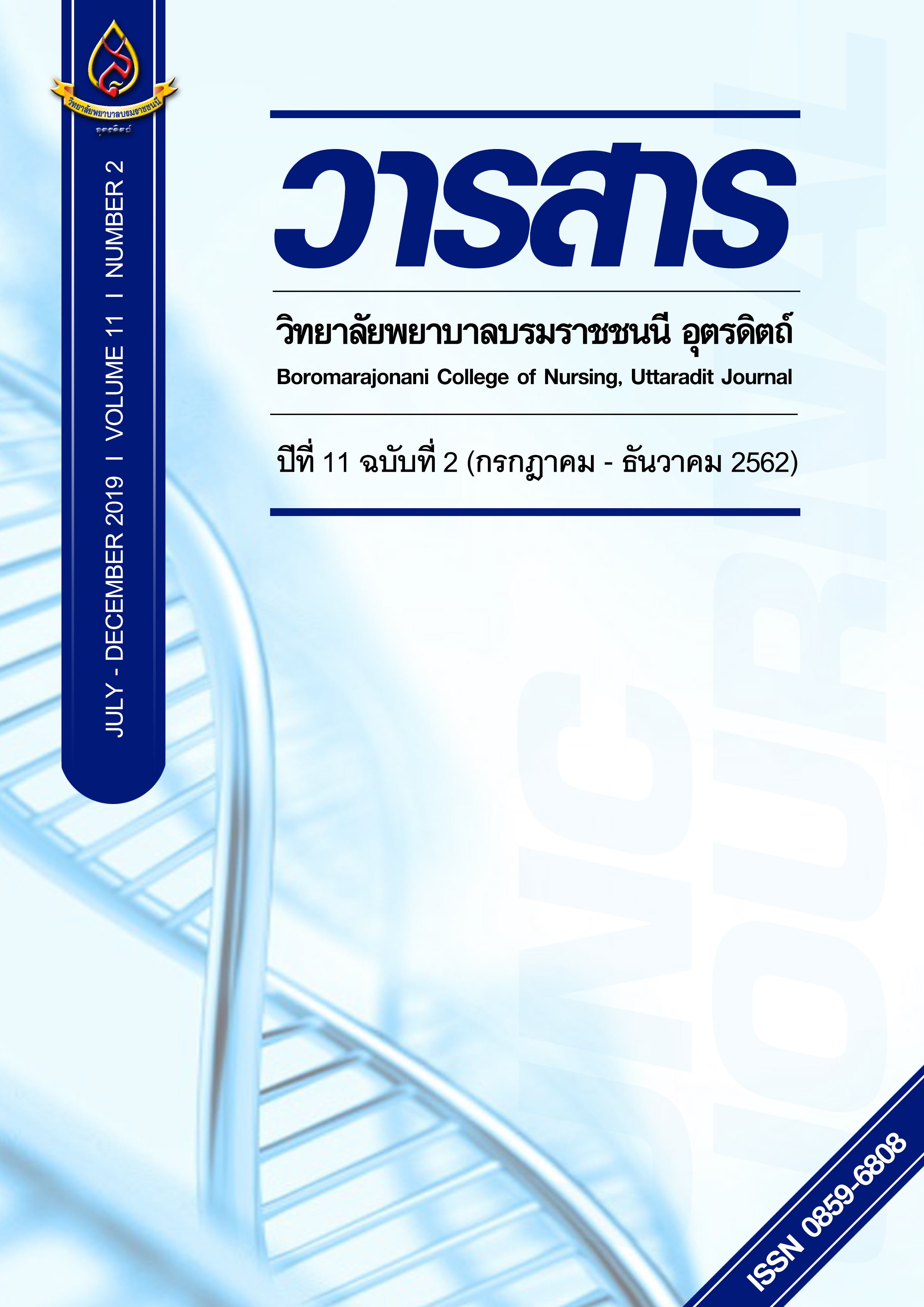พฤติกรรมการเลือกใช้แพทย์แผนโบราณและแพทย์ทางเลือกของผู้ดูแลผู้ป่วยโรคหลอดเลือดสมอง
Main Article Content
บทคัดย่อ
ผู้ดูแลเป็นหนึ่งในบุคคลสำคัญในการตัดสินใจเลือกการรักษาสำหรับผู้ป่วยโรคหลอดเลือดสมองที่กลับมาพักฟื้นที่บ้าน การวิจัยเชิงคุณภาพนี้ มีวัตถุประสงค์เพื่อศึกษาพฤติกรรมการเลือกใช้แพทย์แผนโบราณและแพทย์ทางเลือกของผู้ดูแลผู้ป่วยโรคหลอดเลือดสมอง เลือกกลุ่มตัวอย่างแบบเฉพาะเจาะจง คือผู้ดูแลผู้ป่วยโรคหลอดเลือดสมอง ที่อาศัยอยู่ในพื้นที่ชนบท จังหวัดนครสวรรค์ จำนวน 12 คน เครื่องมือที่ใช้ในการวิจัย คือ แบบสอบถามข้อมูลทั่วไป แบบสัมภาษณ์เชิงลึกแบบกึ่งโครงสร้าง และแบบสังเกต วิเคราะห์ข้อมูลโดยการวิเคราะห์แก่นสาระ ผลการวิจัยแสดงให้เห็นถึงพฤติกรรมของผู้ดูแลในการตัดสินใจเลือกใช้แพทย์แผนโบราณและแพทย์ทางเลือกในการฟื้นฟูสภาพผู้ป่วยโรคหลอดเลือดสมอง สามารถแบ่งเป็น 2 สาระสำคัญคือ 1) ค่านิยมการใช้แพทย์แผนโบราณและแพทย์ทางเลือก 2) แพทย์แผนโบราณและแพทย์ทางเลือกเป็นเมล็ดพันธุ์แห่งความหวัง การวิจัยนี้แสดงให้เห็นถึงสถานการณ์การใช้แพทย์แผนโบราณและแพทย์ทางเลือกในผู้ป่วยโรคหลอดเลือดสมอง รวมทั้งเข้าใจความสัมพันธ์ระหว่างวิถีชีวิตและความเชื่อด้านสุขภาพของคนในชนบท ผลการวิจัยนี้สามารถนำไปใช้ในการปรับปรุงระบบการให้บริการสุขภาพโดยเฉพาะแพทย์แผนโบราณและแพทย์ทางเลือกอย่างเหมาะสม รวมทั้งการตอบสนองนโยบายสาธารณสุขตามแผนพัฒนาระบบบริการการแพทย์ทางเลือกและแพทย์ผสมผสาน ให้สอดคล้องกับสถานการณ์ของผู้ป่วยโรคหลอดเลือดสมอง
Article Details
บทความหรือข้อคิดเห็นใดใดที่ปรากฏในวารสารวิจัยการพยาบาลและวิทยาศาสตร์สุขภาพ เป็นวรรณกรรมของผู้เขียน ซึ่งบรรณาธิการหรือสมาคมศิษย์เก่า ไม่จำเป็นต้องเห็นด้วย และบทความที่ได้รับการตีพิมพ์เผยแพร่ถือเป็นลิขสิทธิ์ของวารสารวิจัยการพยาบาลและวิทยาศาสตร์สุขภาพ
เอกสารอ้างอิง
2) Braun V. & Clarke V. (2006). Using thematic analysis in psychology. Qualitative Research in Psychology, 3, 77-110.
3) Bureau of Information and Communication Technology. (2017). The meaning of values. Retrieved from https://www.kindnessstories.moe.go.th/2017/index.php/th/2-uncategorized/86-img -info1
4) Buttagat V., Eungpinichpong, W., Chatchawan, U. & Arayawichanon, P. (2012). Therapeutic effects of traditional Thai massage on pain, muscle tension and anxiety in patients with scapulocostal syndrome: a randomized single-blinded pilot study. Journal of Bodywork and Movement Therapies, 16(1), 57-63.
5) Dedkhard, S. (2015). Effects of rehabilitation program using complementary therapy in stroke patients. The Journal of Prapokklao Hospital Clinical Medical Education Center, 32(2), 135-146. (in Thai)
6) Department of Thai Traditional and Alternative Medicine. (2015). Guideline of caring for paralysed patients with integrated medicine. Nonthaburi: Ndesign. (in Thai)
7) Department of Thai Traditional and Alternative Medicine. (2017). National Plan for Thai Herbs Development, No. 1 2017-2020. 2nd edit. Samut Prakan: T. S. Printing LTD. (in Thai)
8) Garfinkel, H. (1967). Studies in ethnomethodology. New Jersey: Prentice-Hall.
9) International Health Policy Program Foundation. (2017). Disability-adjusted life years: DALYs year 2014. Nonthaburi: The Graphico System. (in Thai)
10) Mant J. (2011). Introduction to stroke. In J. Mant and M. F. Walker (eds). ABC of Stroke. West Sussex: Wiley-Blackwell, 1-5.
11) Neamsuvan, O., Boontong, J., Boonkaew, M., Sudrak, N., & Moosigapong, K. (2013). A Study on indigenous knowledge of paresis-paralysis treatment from Folk Healers: A Case Study of Mrs. Somporn Sudjai, Chumphon Province. Thai Pharmaceutical and Health Science Journal, 8(2), 51-57. (in Thai)
12) Onthong, S. (2009). Rehabilitation Paralysed Patients with reflexology. Retrieved from https://www.ttmed.psu.ac.th/blog.php?p=2
13) Polit, D. F., & Beck, C.T. (2010). Essentials of nursing research: appraising evidence for nursing practice. (7th ed.). London: Lippincott Williams & Wilkins.
14) Sathienrat, P. (2015). Development plan for Thai traditional medicine and integrative medicine services year 2016. Retrieved from https://hpc.go.th/director/data/plan59/servicePlan_thaiMedicine.pdf
15) Singhpoo, K., Tiamkao S., Kuchaisit C., Ariyanuchitkul S., Sangpongsanon S., Kamsa-ard S., & Chantachume W. (2009). The quality of life of stroke outpatients at Srinagarind Hospital. Journal of the Medical Association of Thailand, 92(12), 1602-1609.
16) Supot Kamsa-ard BSc*, Watsana Chantachume BSc, Suwankhong D., Liamputtong, P., & Rumbold, B. (2011). Existing roles of traditional healers (mor baan) in southern Thailand. Journal of Community Health, 36(3), 438-445.
17) Thaneerat, T. (2008). What is alternative medicine? Journal of Burean of Alternative Medicine,1(1), 7-8. (in Thai)
18) World Health Organization. (2013). WHO traditional medicine strategies, 2014-2023. HongKong SAR: China.


